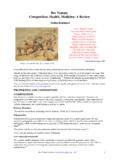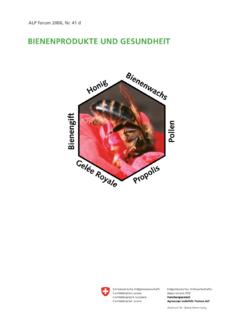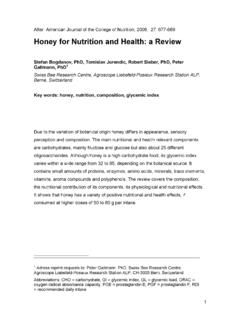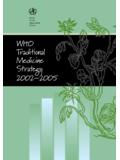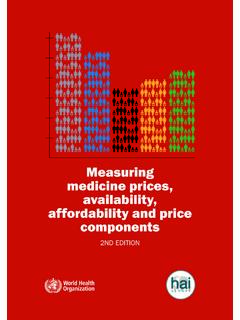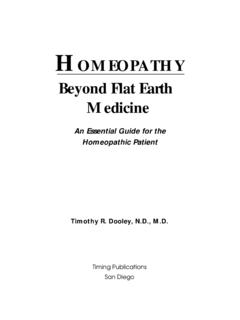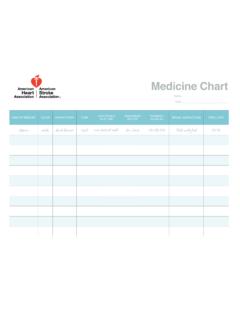Transcription of Honey in Medicine: A Review - bee-hexagon.net
1 Bee Product Science, 2017 1 Honey in medicine : A Review Stefan Bogdanov SHORT HISTORY OF Honey IN medicine Pabasa tombs, 26th Dynasty, 760-656 BC Wound healing was probably the first use of Honey for human health. In the oldest human scriptures from Sumer, dating back about 2000 BC a prescription for treating wounds states: Grind to a powder river dust and .. (words missing) then knead it in water and Honey and let plain oil and hot cedar oil be spread over it75 According to the Ebers papyrus (1550 BC) Honey is included in 147 prescriptions in external applications: Mix Honey , red ochre, powdered alabaster to cure spotted baldness or includes Honey after surgery, as suppository and to reduce inflammation.
2 75 According to the Smith papyrus (1700 BC) it was used in wound healing: Thou shouldst bind [the wound] with fresh meat the first day [and] treat afterwards with grease, Honey [and] lint every day until he recovers. 75 In the first compendium of ancient Chinese medicine Shen Nang, compiled many years BC, and mentioned in a written form for the first time around 200 AD there are many prescriptions and medical indications which contain honey140. In ancient India ayuruvedic medicine uses Honey for many purposes. According to the Ayruveda classic Ashtanga Hridaya, written about 500 AD Honey can be used against many diseases, healing and cleaning wounds, against different internal and external infections82 Preparation of Honey medicine from Materia Medica, Dioscorides, Arab translation 1224 The ancient Greeks considered Honey as medicine and believed that if bee Honey is taken regularly human life could be prolonged.
3 Early thinkers such as Homer, Pythagoras, Ovid, Democritus, Hippocrates and Aristotle mentioned that people should eat Honey to preserve their health and vigour. Dioscorides, in the first century AD (see picture to the left) used Honey for treating wounds85 Honey was the most useful substance used in old Roman pharmacopoeia. Pliny writes that it is good for afflictions of the mouth, pneumonia, pleurisy and snake bites75 The wise Solomon praises the virtues of Honey in the old testament. The Koran says thy Lord taught the bee to build its cells in hills, on trees and in (men's) there issues from within their bodies a drink of varying colours, wherein is healing for mankind (Quran 16:68-69). The ancient Maya civilisations used Melipona (stingless bee) Honey in the treatment of cataracts75 Today the knowledge on the healing virtues of Honey and the other bee product is called apitherapy is compiled in many books or on the Internet , Bee Product Science, 2017 2 Honey IN TRADITIONAL medicine Honey in traditional Chinese medicine Honey was mentioned as medicine by Shen Nang, some 2000 BC.
4 In the 52 prescription book,. 3th century BC includes a prescription including Honey . According to Chinese medicine Honey has a balanced character (neither Yin nor Yang) and acts according to the principles of the Earth element, entering the lung, spleen and large intestine channels. There are many original prescriptions and medical indications which contain honey140 Christopher Gussa a TCM practioneer writes on : Honey is known as Feng Mi and has the ability to nourish yin energy and strengthen the spleen. Apart from its widely recognized nutritional value, Honey is also the Chinese people's favorite as a "neutral" food with medicinal properties. In the "Compendium of Materia Medica," the TCM classic by pharmacist Li Shizhen in the Ming Dynasty (1368-1644), " Honey can help dispel pathogenic heat, clear away toxins, relieve pain and combat dehydration.
5 " Li Shizhen showed that eating Honey regularly resulted in clear sight and rosy cheeks. He also wrote that eating Honey every morning can help prevent constipation and it is a good choice for those who suffer chronic coughing. TCM also shows that due to Honey 's affinity for the stomach and spleen it can greatly enhance the effect of many of the super-tonics such as He Shou Wu According to the Fundamentals of Chinese medicine Honey has following properties balanced, sweet, non-toxic. Enters the lung, spleen and the large intestine meridian channels. Supllements the center and moistens the lung. Relieves pain and resolves cough due to lung dryness; constipation due to dryness of the intestines; stomach pain; deep source nasal congestion, mouth sores, scalds and burns 22 Sui Wan summirises: Honey has been used in traditional Chinese medicine to treat many diseases for more than two thousands years.
6 In Traditional Chinese Medication, Honey is a combination used with bee venom, propolis, royal jelly, pollen and other herbal medications in medical treatment. In addition, the following diseases are good indications for using Honey . I) Infectious Diseases: Bacterial Infections: A. Infections caused by gram-positive bacteria, Streptococcal infections- Pharyngitis, Enterococcal infections, Pneumococcal infections; Staphyloccus Aureus infections, B. Infections caused by gram-negative bacteria, Meningococcal infections- Meningococcal meningitis., Salmonellae infections-Typhoid fever, Salmonella Gastro-enteritis., Shigella infections-Shigella dysentery. II) Gastrointestinal Diseases: A. Gastritis, B. Peptic ulcer Disease, C. Celiac Disease, D.
7 Antibiotic-Associated Colitis. E. Inflammatory Bowel Diseases. III) Allergic and Immunologic Disorders: A. Allergic Rhinitis B. Rheumatoid arthritis, C. Systemic Lupus Erythematous(SLE), D. Ankylosing spondylitis, E. Multiple Sclerosis. IV) Traumatic wounds: traumatic and surgical wounds managements 144 Honey in Ayurveda medicine Honey has a long tradition in traditional ayurveda medicine . This topic has been reviewed by 127 According to D Ramanathan, director of the Sitaram Ayurveda Pharmacy Limited & Specialty Hospital, Thrissur on the role Honey plays in ayurvedic treatment: Honey known as madhu in ayurvedic scriptures is one of the most important medicines used in ayurveda. In ayurveda, Honey is used for both internal and external applications.
8 It is mainly used for the treatment of eye diseases, cough, thirst, phlegm, hiccups, blood in vomit, leprosy, diabetes, obesity, worm infestation, vomiting, asthma, diarrhoea and healing wounds. It is also used as a natural preservative and sweetener in many ayurvedic preparations. It is also used as a vehicle along with some medicines to improve its efficacy or to mitigate the side effects of the other medicines it is mixed with. It is also known to mitigate the increased kapha dosha. (Kapha dosha is the ayurvedic category for body constitutions- those with kapha dosha are of larger proportions with robust frame.) It should also be kept in mind that fresh Honey helps to increase body mass while old Honey produces constipation and decreases body mass.
9 Honey should not be heated or consumed warm as it causes toxic effect. Cold Honey should always be preferred. According to ayurveda, there are eight different types of Honey : : Used in the treatment of eye diseases, hepatitis, piles, asthma, cough and tuberculosis : Used in the treatment when blood is vomited Bee Product Science, 2017 3 : Used in the treatment of diabetes : Used in the treatment of diabetes and urinary infection : Used in the treatment of worm infestation, when blood is vomited and diabetes : Effective for eye diseases, cough and anaemia : Increases taste and in the treatment of leprosy and poisoning cases : It increases digestion and helps in the treatment of cough, vomiting and diabetes. (The gathering of these honeys in described in 127) We prescribe a particular brand called Samskritha Madhu (which means cultured or purified Honey ) which is made by most of the authentic ayurvedic Manufacturing units as per the ayurvedic scriptures.
10 In ayurveda, what is the bee species that is most preferred- are they are Italian species (that are kept in boxes) or Indian species (that are found in the wild). As far as Ayurveda is concerned our acharyas who made this system of medicine utilized Indian Honey and tested the wild Honey , hence any ayurvedic physician will prefer the Indian Honey wild Honey Honey in traditional medicine A traditional medicine branch, called apitherapy, has developed in recent years, offering treatments based on Honey and the other bee products against many diseases. The knowledge on this subject is compiled in various books 34, 80, 125 or on relevant web pages such as , Unifloral Honey in practical apitherapy after33 Honey type Applications Acacia, liquid and mild; Sweetener for people with Diabetis Type II.
